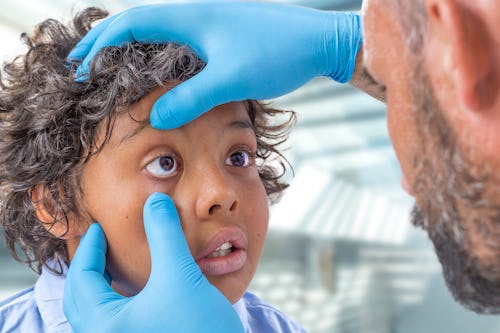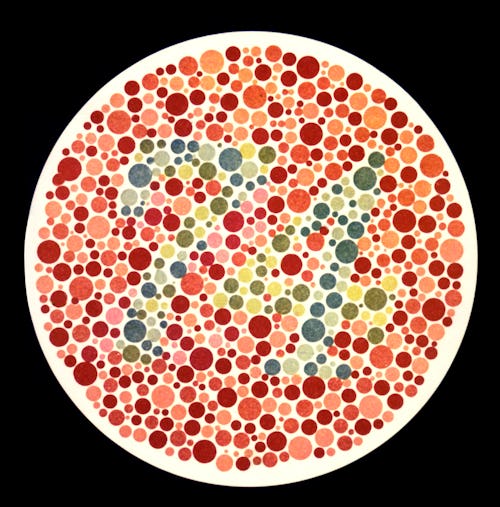
So much of childhood is related to color. Adults ask toddlers to name their favorite colors almost as much as they ask them to make animal sounds. "Red Light, Green Light" is an actual game; there are full episodes of kid’s TV shows devoted to learning different hues. But what if your child won't tell you what color the sky is? Or misidentify some colors that you thought they were able to label before? How can you tell if your toddler or older child is color blind, and what are the long-term implications?
What is color blindness?
Pediatric ophthalmologist Dr. Patrick Burke describes color blindness as such: “Color blindness more accurately can be called ‘color deficiency,’ since most people with this trait still see some colors rather than a complete absence of color. It results from a genetic mutation that affects the cells that detect color in our eyes. This makes it very difficult or impossible to distinguish between certain colors, and causes two different colors to look exactly the same.”
Color deficiency most commonly causes red and green to look the same, and can also be present in colors like purple and brown which contain traces of reds and greens.
Because “blindness” can be alarming to hear, doctors are careful about the terms they use, especially when speaking with parents. "We often say a child has a red-green deficiency, rather than saying they are color blind,” says Dr. Rob Darzynkiewicz, Chief Medical Officer of Hazel Health.
How common is color blindness?
Color blindness might be more common than you think. “Inherited color blindness is much more common in males than females,” says Dr. Valerie M. Kattouf, a pediatric optometrist and medical reviewer at All About Vision. According to Kattouf, approximately 8% of males and 0.5% of the females experience color blindness.
What causes it?
A hereditary condition, there is a very specific way the color deficiency gene is passed down. “Color blindness is an X-linked recessive condition inherited through the maternal line,” Dr. Mohamed Jaafar, an ophthalmologist at Children's National Hospital tells Romper. It usually plays out like this: “maternal grandfather has it, mother usually does not have it, and it then appears in the grandsons.”
Darzynkiewicz explains why males have a higher chance of being color blind: “[The gene for red-green and blue vision can be found on the sex chromosome X. Women have XX and men XY. If one X has the gene that is not working well, but the other X works you will probably be fine. That's why girls are rarely color blind. For boys, they only get one X gene from their mom, and if it's the faulty one, they're at risk for being color deficient.”

Signs of color blindness
It can be difficult to identify whether or not your child has a color deficiency. “Most parents don’t notice any symptoms,” Jaafar tells Romper. Since the trait is usually present from birth, this is the way your child perceives the world, so typically, “the child is not aware of it” either, he says.
Our experts say these are some signs and examples of color deficiency in children:
- They have difficulty telling colors apart, especially differentiating between red and green
- They select clothing, like socks, that are mismatched
- They are sensitive to bright lights
- They have trouble focusing on coloring worksheets
- They are suspicious of new foods and want to smell anything new they eat and have a strong sense of smell
- They use the wrong color for common items, like green to color in a fire hydrant
Diagnosing color blindness in children
A catch-22 within the color deficiency diagnosis, as Burke says, is that “Most eye doctors wait until children are old enough to actively participate in testing (around 4 to 6 years old), since the tests can be unreliable before that. However, it's important to make this diagnosis early so the child's school can be alerted and lesson plans can be adjusted accordingly.”
The Ishihara Color Test is the most prevalent test for red-green color-blindness; the test is best given to a child under doctor’s supervision as certain computer screens can skew the colors and render the test inaccurate.

“Color blindness/deficiency can typically be detected during a comprehensive eye examination as young as 3 years old,” Kattouf explains. “A simple book of test plates will be shown to your child. They will be asked to recognize shapes or numbers. The ability to recognize the shapes or numbers versus the inability to recognize the test plates determines if a patient is color blind.”
Children develop at different rates, so if you feel your child is slow to identify colors, by no means does it mean that they’re color blind. A fascinating article written by Melody Dye of The Scientific American pointed out that learning colors can be especially hard in English because we use the shade indicator before the noun it's describing, or “prenominally” — the blue crayon, for example — but putting the color last can actually be more helpful. Dye wrote, “Say 'the balloon is red'... and you will have helped to narrow 'red-ness' to being an attribute of the balloon, and not some general property of the world at large. This helps kids discern what about the balloon makes it red.'
Long-term impacts of having a color deficiency
Sure, some things might be more challenging if child is seeing the world in mostly shades of grey, but it will not affect their health or vision. A diagnosis does not mean they will need any glasses, contacts, or corrective measures unless there are other eye issues present. In fact, according to the Archimedes Laboratory Project, people with color blindness will likely have better night vision and see more variations in luminosity.
“There are very few implications of color vision deficits,” Kattouf tells Romper. “Most children operate at full capacity with no limitations.” It can be helpful, however, to let teachers and other caregivers know that your child is color blind in case there is anything they need to adapt lesson plan-wise for your child.
Later in life, Kattouf says that color blindness may impact a person’s ability to pursue a career such as a pilot or an electrician where the ability to differentiate colors plays a major role, but does note that “there are newly developed spectacle and contact lens technologies that may help eliminate limitations due to color vision deficiencies” and that “most adults with color blindness are well adapted and many are unaware of any limitations.”
What to do if your child is color blind
Darzynkiewicz suggests the following to help set up your child for success.
- Once your child is reading, label their makers and crayons with specific colors to avoid unnecessary frustration.
- Make every adult who cares for your child (tutors, coaches, teachers, babysitters) aware of the situation so they avoid frustrating situations (for example playing sports with red versus green uniforms, or using a red-and-green board for chess or checkers).
- Talk to your child’s school to avoid situations where your child hears they are incorrect about colors and may start to think they're not smart or capable.
- Normalize color deficiency by talking openly about it with your child, and creating a plan for them to advocate for themselves when you’re not around.
- Stop to consider how your child views the world and change your language accordingly. For example, instead of saying you’re parked by a red car, say you’re parked by a street light. Or describe a person’s shirt by the pattern or illustration on it as opposed to the color.
“If they're frustrated it may be about color perception, so don’t be afraid to ask. Let them know you are there, you care and want to learn from their experiences,” he advises.
Experts
Dr. Patrick Burke, pediatric ophthalmologist at Hampton Roads
Dr. Rob Darzynkiewicz, Chief Medical Officer of Hazel Health
Dr. Valerie M. Kattouf, a pediatric optometrist and medical reviewer at All About Vision.
Dr. Mohamed Jaafar, an ophthalmologist at Children's National Hospital

0 comments:
Post a Comment